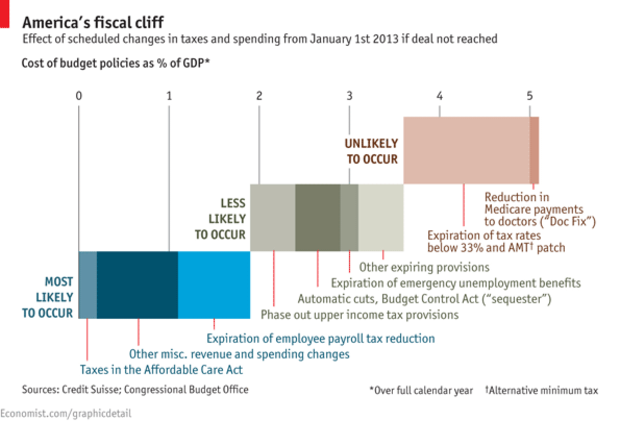"Fiscal cliff" could hurt jobs
(MoneyWatch) Last week, the government revised third quarter growth from 2 percent to 2.7 percent, but don't be wowed by the headline increase. The boost in growth came from faster inventory accumulation, a trend that is unlikely to repeat itself in the fourth quarter. As a result, many analysts have downgraded the fourth quarter to only 1 percent growth. If that were to occur, growth for all of 2012 would total only 1.75 percent.
Five years since the beginning of the Great Recession, there is still a feeling of relief when the government reports a plus sign in front of the GDP report. That said, sub-2 percent growth is not strong enough to create an ample number of jobs. Job creation will be front and center this week. Analysts expect that 80,000 new jobs were created in November, which would be a marked slowdown from October's 171,000 jobs. The unemployment rate will likely come in at 7.9 - 8 percent.
Blame superstorm Sandy for the fall-off in job creation, which is better than a general loss of momentum in the labor market. Sandy made landfall on Oct. 29, but the Labor Department conducts its payroll survey mid-month, so the impact will be felt in the November report. Additionally, the "fiscal cliff" has created uncertainty among businesses, which has kept a lid on more robust job growth.
The Economist created this great chart, outlining the various possibilities for a deal and the cost of budget policies as a percentage of GDP.
Most of the talk has focused on allowing the 2001 and 2003 tax cuts to expire for taxpayers who earn over $200,000 as single filers and $250,000 for joint filers, which would reduce the 2020 budget deficit by $110,000 billion. That may sound like a big number, but it amounts to just a tenth of that year's projected $1.1 trillion shortfall. Putting a cap on itemized deductions, like mortgage interest and charitable contributions, to 15 percent of earnings would help reduce the deficit by another $150 billion. These numbers lead many economists to predict that eventually taxes are likely to rise for all Americans.
Stocks finished the week in the plus column, while the month of November was mixed. The S&P 500 has recovered 4.1 percent from a recent closing low on Nov. 15 and now down only 3.9 percent from its Sept. 14 high for the year, down just 1.3 percent since the elections.
-- DJIA: 13,025, up 0.1 percent on week, down 0.5 percent on month, up 6.6 percent on year
-- S&P 500: 1,416 up 0.5 percent on week, up 0.3 percent on month, up 12.6 percent on year
-- NASDAQ: 3,010 up 1.5 percent on week, up 1.1 percent on month, up 15.6 percent on year
-- January Crude Oil: $88.28, down 0.1 percent on week
-- February Gold: $1,712.70, down 2.2 percent on week
-- AAA nat'l average price for gallon of regular gas: $3.40
THE WEEK AHEAD:
Mon 12/3:
10:00 ISM Manufacturing Index
10:00 Construction spending
Tues 12/4:
Motor vehicle sales
Weds 12/5:
7:00 MBA mortgage purchase applications index
8:15 ADP private employment report
8:30 Productivity and costs
10:00 Factory orders
10:00 ISM Non-Manufacturing Index
Thurs 12/6:
7:30 Challenger job cuts
8:30 Weekly claims
Fri 12/7:
8:30 November employment report
9:55 Consumer credit
